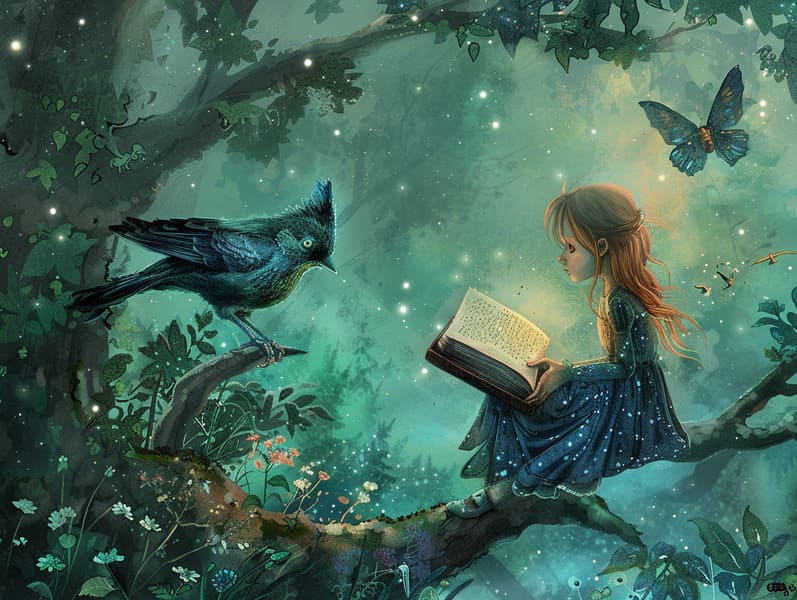Tracing the Heritage of Mythical Fairy Tales with Their Unwavering Elegance.
Tracing the Heritage of Mythical Fairy Tales with Their Unwavering Elegance.
Blog Article

Fairy tales for kids have timeless appeal. These narratives have been relayed from one generation to the next far before they were ever transcribed. They emerged from a variety of cultures, including Middle Eastern traditions. They were initially conveyed among adults, often carrying themes and messages relevant to the societal norms and beliefs of the time.
The Brothers Grimm, Jacob and Wilhelm Grimm, were among the first to compile many of these beloved stories. Their volume, "Grimm's Folk Tales," included narratives like "Cinderella," "Little Brother and Little Sister," and "Snow White," which have since become mainstays in the world of beloved fairy tales. Similarly, the Danish author's fanciful narratives, such as "The Story of the Little Mermaid," and "The Story of the Ugly Duckling," have captured hearts worldwide, solidifying their place in the pantheon of iconic fairy tales.
Despite their age, fairy tales remain as meaningful as ever, especially as bedtime stories for kids. These enchanting tales are now available in numerous formats, including vividly illustrated books, whimsical animations, and digital storybooks.
Their ongoing significance can be attributed to several whimsical characteristics:
Key Lessons: Classic fairy tales often offer important moral lessons. Fairy tales like "The Boy Who Cried Wolf" teach the significance of sincerity, while "The Hare and the Tortoise" highlight the qualities of steadfastness and unpretentiousness. These tales offer kids clear distinctions between good and bad, molding their moral compass in a gentle yet profound way.
Compassion and Insight: Fairy tales frequently present personalities facing obstacles and hardships, provoking audiences to sympathize with their struggles and support their triumphs. For instance, "The Tale of Beauty and the Beast" points out the merit of seeing beyond looks to comprehend the real person of a being, enhancing insight and appreciation.
Cultural Perception: Many timeless fairy tales are deeply embedded in the cultural contexts from which they developed. Reading these stories can provide enlightening views into different ways of life, nurturing a sense of world respect and recognition.
Imagination and Creativity: The fanciful elements in timeless fairy tales—magical spells—awaken children’s visions. These tales bring readers to fantastical realms, generating creative dreams and a here sense of fascination that endures a lifetime.
Classic fairy tales are not only charming but also teaching. They serve as fascinating tools in cultivating various thinking and feeling skills in young ones. When ancient fairy tales are recited, they enhance language acquisition by introducing new vocabulary and elaborate sentence structures. This practice also strengthens listening skills and attentiveness, as the young focus on every detail, excited to see what happens next.
Furthermore, reflecting on the themes and characters of classic fairy tales can advance problem-solving abilities and thought processes. Little ones learn to discern patterns, foresee events, and know cause and effect. These reflections also help little ones speak out their thoughts and feelings, adding to their emotional intelligence.
In today’s information age, the presence of online fairy tales has made these narratives more acquirable than ever. Internet sites and software share extensive collections of bedtime fairy tales that can be seen or heard anytime, anywhere. Fairy tales read aloud are particularly widespread, featuring an fascinating method for the young to relish these mesmerizing stories. Read-aloud books and voiced videos move characters and settings to life, often paired with fantastical background sounds and songs that improve the tale experience.
The timeless appeal of traditional fairy tales lies in their ability to adjust to modern society while maintaining their core messages. Contemporary reinterpretations of these stories often bring in more multicultural protagonists and modern settings, making them accessible to today’s audience. However, the main ideas of valour, sympathy, and fair-mindedness remain unchanged, continuing to appeal to young readers of all ages.
Traditional fairy tales also offer a sense of coziness and comprehensibility. They allow a orderly narrative with a recognizable beginning, middle, and end, often concluding with the wrap-up of conflicts and the triumph of goodness over badness. This steadiness can be soothing for young readers, giving a sense of consistency in an ever-changing world.
Ancient fairy tales continue to allure and edify new generations, maintaining their fascination and applicability in modern society. As children's night stories, they present a perfect blend of wonder and wisdom, enhancing moral values, empathy, and creativity. The availability of digital storybooks and the likability of fairy tales recited make sure that these ancient stories remain within reach to new generations.
By defending and passing on these stories, we continue to pay tribute to the rich tapestry of human imagination and cultural heritage. Whether you are perusing a artistically illustrated book, browsing a web collection, or playing an read-aloud story, the spell of children's fairy tales is always within reach. These tales illustrate of the continued magic of stories and its ability to join us across time and space.
If you are perusing a richly illustrated book, delving into a electronic library, or listening to an audio story, the elegance of timeless fairy tales is always within reach.
These stories convey of the everlasting ability of narratives and its ability to unite us across eras and regions, making a tie that enchants and educates alike.